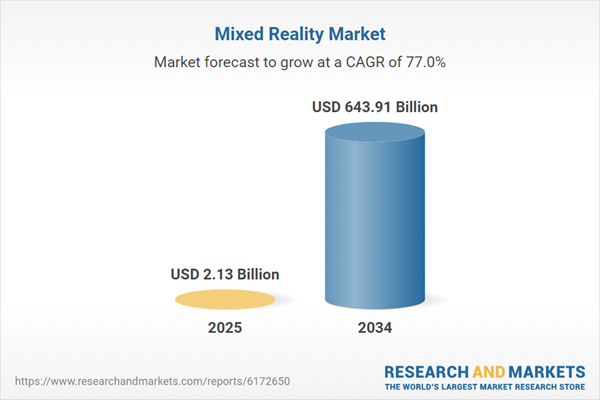The market is further being driven by evolving technologies, such as 5G technology and IoT technology, and the availability of low-cost hardware that allows the mixed reality industry to thrive and evolve. Thus, the market is projected to grow at a CAGR of 77% during the forecast period of 2025-2034 to attain a value of nearly USD 20.70 billion by 2026.
Increasing Demand for 5G Technology and IoT Technology to Augment the Market Growth
Computer graphics, signal processing, computer apparition, user interfaces, mobile computing, wearable computing, information visualisation, and display and sensor design are all part of mixed reality. The market for mixed reality is being catalysed by the rising automation and digitisation trends being witnessed across industries. Various industries, including automotive and healthcare, along with offices, are rapidly adopting mixed reality principles. The rising popularity of 5G technology, IoT technology, and the availability of low-cost hardware, among other factors, are boosting the market growth of mixed reality. The factors are expected to continue to boost the market growth in the coming years.North America is a Leading Market for Mixed Reality, with the Asia-Pacific Being the Fastest Growing Market
North America was a significant contributor to the growth of the mixed reality industry in 2020 and is expected to maintain its dominance in the market in the coming years. This is due to a rise in mixed reality gadget usage, along with the introduction of favourable policies propelling the adoption of 5G technology and artificial intelligence. Within North America, the United States is the leading market for mixed reality due to the increasing acceptance of technologically sophisticated solutions, as well as the increased emphasis on digitalisation and artificial intelligence, in the country.
The Asia-Pacific area, on the other hand, is anticipated to be the fastest-growing market over the forecast period. In the rising economies, such as China and India, there has been a rise in the adoption of advanced technologies, an expansion of downstream industries, and a growth in the proliferation of smartphone devices. This has aided the growth of the mixed reality industry within the region. Furthermore, the use of mixed reality in educational technologies is projected to accelerate the growth of the mixed reality industry in the Asia-Pacific.
Mixed Reality Industry Segmentation
The regulated clash of the AR/VR and IoT developments is symbolised by mixed reality. It is the blending of the real and virtual worlds in order to create new representations and settings in which digital and physical things, as well as their data, may co-exist and interact. Mixed reality uses a projector to project pictures onto semi-transparent materials, which are subsequently reflected to the eye via beam-splitting technology. Maintenance and operations, production, design and development, reporting and analytics, quality control, and distribution are all locations where mixed reality is being used.Based on components, the market is bifurcated into:
- Hardware
- Software
On the basis of application, the industry is segmented into:
- Automotive and Aerospace
- Medical
- Entertainment
- E-Commerce and Retail
- Others
Market Breakup by Region
- North America
- Europe
- Asia-Pacific
- Latin America
- Middle East and Africa
Investments in devices, software ecosystems, and platforms fuelled by mixed reality is expected to propel the growth of the market. The ultimate objective of these investments is to replace keyboards and flat screens in the industry with a new business model. In the present technological era, this is expected to lead to a higher user involvement level. Every enhancement to the user interface patterns improves the functionality of typing, clicking, touching, and swiping, allowing users to advance "beyond the glass" of traditional displays. This is projected to support the market growth of mixed reality in the coming years.
Further, as organisations explore and go beyond pilot applications, the enterprise potential of mixed reality continues to expand. Enhanced attempts to combine IoT technology's potential with the help of sensors and linked devices, which help to develop a more integrated physical and digital landscape, are resulting in significant infrastructure investments. Wearable technology is one of the foundations for some of the most complex and immersive mixed reality experiences now available in the market. Wearables are expected to find a wide range of applications within various industries and businesses. Moreover, many types of field operations, such as maintenance and delivery services, may also benefit from the expansion of the wearables segment, such as Microsoft’s HoloLens. These factors are expected to support the growth of the market in the coming years.
Key Industry Players in the Global Mixed Reality Market
The report gives a detailed analysis of the following key players in the global mixed reality market, covering their competitive landscape, capacity, and latest developments like mergers, acquisitions, and investments, expansions of capacity, and plant turnarounds:- Amber Garage
- Microsoft Corporation
- Canon Inc.
- Samsung Electronics Co., Ltd.
- HP Development Company, L.P.
- Brainlab AG
- Others
Table of Contents
Companies Mentioned
The key companies featured in this Mixed Reality market report include:- Amber Garage
- Microsoft Corporation
- Canon Inc.
- Samsung Electronics Co., Ltd.
- HP Development Company, L.P.
- Brainlab AG
Table Information
| Report Attribute | Details |
|---|---|
| No. of Pages | 167 |
| Published | August 2025 |
| Forecast Period | 2025 - 2034 |
| Estimated Market Value ( USD | $ 2.13 Billion |
| Forecasted Market Value ( USD | $ 643.91 Billion |
| Compound Annual Growth Rate | 77.0% |
| Regions Covered | Global |
| No. of Companies Mentioned | 7 |









